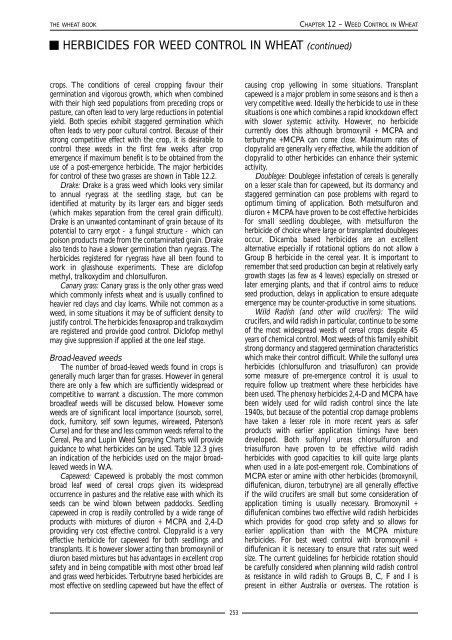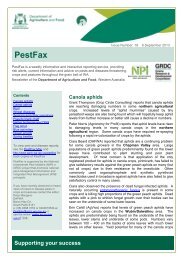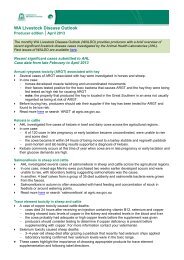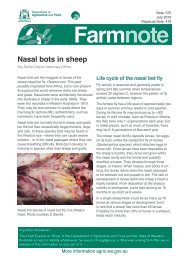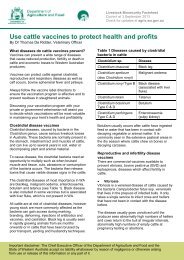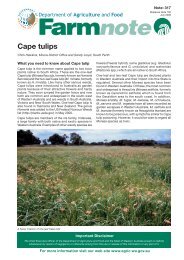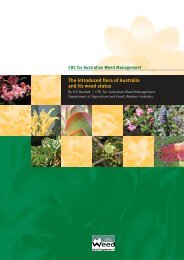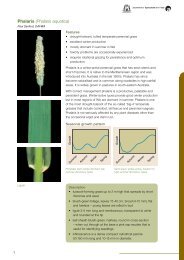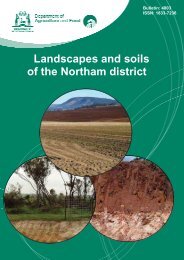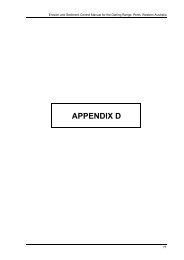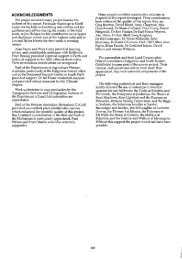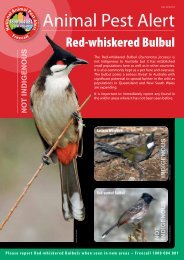The wheat book : principles and practice - Department of Agriculture ...
The wheat book : principles and practice - Department of Agriculture ...
The wheat book : principles and practice - Department of Agriculture ...
Create successful ePaper yourself
Turn your PDF publications into a flip-book with our unique Google optimized e-Paper software.
THE WHEAT BOOK CHAPTER 12 – WEED CONTROL IN WHEAT<br />
HERBICIDES FOR WEED CONTROL IN WHEAT (continued)<br />
crops. <strong>The</strong> conditions <strong>of</strong> cereal cropping favour their<br />
germination <strong>and</strong> vigorous growth, which when combined<br />
with their high seed populations from preceding crops or<br />
pasture, can <strong>of</strong>ten lead to very large reductions in potential<br />
yield. Both species exhibit staggered germination which<br />
<strong>of</strong>ten leads to very poor cultural control. Because <strong>of</strong> their<br />
strong competitive effect with the crop, it is desirable to<br />
control these weeds in the first few weeks after crop<br />
emergence if maximum benefit is to be obtained from the<br />
use <strong>of</strong> a post-emergence herbicide. <strong>The</strong> major herbicides<br />
for control <strong>of</strong> these two grasses are shown in Table 12.2.<br />
Drake: Drake is a grass weed which looks very similar<br />
to annual ryegrass at the seedling stage, but can be<br />
identified at maturity by its larger ears <strong>and</strong> bigger seeds<br />
(which makes separation from the cereal grain difficult).<br />
Drake is an unwanted contaminant <strong>of</strong> grain because <strong>of</strong> its<br />
potential to carry ergot – a fungal structure – which can<br />
poison products made from the contaminated grain. Drake<br />
also tends to have a slower germination than ryegrass. <strong>The</strong><br />
herbicides registered for ryegrass have all been found to<br />
work in glasshouse experiments. <strong>The</strong>se are dicl<strong>of</strong>op<br />
methyl, tralkoxydim <strong>and</strong> chlorsulfuron.<br />
Canary grass: Canary grass is the only other grass weed<br />
which commonly infests <strong>wheat</strong> <strong>and</strong> is usually confined to<br />
heavier red clays <strong>and</strong> clay loams. While not common as a<br />
weed, in some situations it may be <strong>of</strong> sufficient density to<br />
justify control. <strong>The</strong> herbicides fenoxaprop <strong>and</strong> tralkoxydim<br />
are registered <strong>and</strong> provide good control. Dicl<strong>of</strong>op methyl<br />
may give suppression if applied at the one leaf stage.<br />
Broad-leaved weeds<br />
<strong>The</strong> number <strong>of</strong> broad-leaved weeds found in crops is<br />
generally much larger than for grasses. However in general<br />
there are only a few which are sufficiently widespread or<br />
competitive to warrant a discussion. <strong>The</strong> more common<br />
broadleaf weeds will be discussed below. However some<br />
weeds are <strong>of</strong> significant local importance (soursob, sorrel,<br />
dock, fumitory, self sown legumes, wireweed, Paterson’s<br />
Curse) <strong>and</strong> for these <strong>and</strong> less common weeds referral to the<br />
Cereal, Pea <strong>and</strong> Lupin Weed Spraying Charts will provide<br />
guidance to what herbicides can be used. Table 12.3 gives<br />
an indication <strong>of</strong> the herbicides used on the major broadleaved<br />
weeds in W.A.<br />
Capeweed: Capeweed is probably the most common<br />
broad leaf weed <strong>of</strong> cereal crops given its widespread<br />
occurrence in pastures <strong>and</strong> the relative ease with which its<br />
seeds can be wind blown between paddocks. Seedling<br />
capeweed in crop is readily controlled by a wide range <strong>of</strong><br />
products with mixtures <strong>of</strong> diuron + MCPA <strong>and</strong> 2,4-D<br />
providing very cost effective control. Clopyralid is a very<br />
effective herbicide for capeweed for both seedlings <strong>and</strong><br />
transplants. It is however slower acting than bromoxynil or<br />
diuron based mixtures but has advantages in excellent crop<br />
safety <strong>and</strong> in being compatible with most other broad leaf<br />
<strong>and</strong> grass weed herbicides. Terbutryne based herbicides are<br />
most effective on seedling capeweed but have the effect <strong>of</strong><br />
253<br />
causing crop yellowing in some situations. Transplant<br />
capeweed is a major problem in some seasons <strong>and</strong> is then a<br />
very competitive weed. Ideally the herbicide to use in these<br />
situations is one which combines a rapid knockdown effect<br />
with slower systemic activity. However, no herbicide<br />
currently does this although bromoxynil + MCPA <strong>and</strong><br />
terbutryne +MCPA can come close. Maximum rates <strong>of</strong><br />
clopyralid are generally very effective, while the addition <strong>of</strong><br />
clopyralid to other herbicides can enhance their systemic<br />
activity.<br />
Doublegee: Doublegee infestation <strong>of</strong> cereals is generally<br />
on a lesser scale than for capeweed, but its dormancy <strong>and</strong><br />
staggered germination can pose problems with regard to<br />
optimum timing <strong>of</strong> application. Both metsulfuron <strong>and</strong><br />
diuron + MCPA have proven to be cost effective herbicides<br />
for small seedling doublegee, with metsulfuron the<br />
herbicide <strong>of</strong> choice where large or transplanted doublegees<br />
occur. Dicamba based herbicides are an excellent<br />
alternative especially if rotational options do not allow a<br />
Group B herbicide in the cereal year. It is important to<br />
remember that seed production can begin at relatively early<br />
growth stages (as few as 4 leaves) especially on stressed or<br />
later emerging plants, <strong>and</strong> that if control aims to reduce<br />
seed production, delays in application to ensure adequate<br />
emergence may be counter-productive in some situations.<br />
Wild Radish (<strong>and</strong> other wild crucifers): <strong>The</strong> wild<br />
crucifers, <strong>and</strong> wild radish in particular, continue to be some<br />
<strong>of</strong> the most widespread weeds <strong>of</strong> cereal crops despite 45<br />
years <strong>of</strong> chemical control. Most weeds <strong>of</strong> this family exhibit<br />
strong dormancy <strong>and</strong> staggered germination characteristics<br />
which make their control difficult. While the sulfonyl urea<br />
herbicides (chlorsulfuron <strong>and</strong> triasulfuron) can provide<br />
some measure <strong>of</strong> pre-emergence control it is usual to<br />
require follow up treatment where these herbicides have<br />
been used. <strong>The</strong> phenoxy herbicides 2,4-D <strong>and</strong> MCPA have<br />
been widely used for wild radish control since the late<br />
1940s, but because <strong>of</strong> the potential crop damage problems<br />
have taken a lesser role in more recent years as safer<br />
products with earlier application timings have been<br />
developed. Both sulfonyl ureas chlorsulfuron <strong>and</strong><br />
triasulfuron have proven to be effective wild radish<br />
herbicides with good capacities to kill quite large plants<br />
when used in a late post-emergent role. Combinations <strong>of</strong><br />
MCPA ester or amine with other herbicides (bromoxynil,<br />
diflufenican, diuron, terbutryne) are all generally effective<br />
if the wild crucifers are small but some consideration <strong>of</strong><br />
application timing is usually necessary. Bromoxynil +<br />
diflufenican combines two effective wild radish herbicides<br />
which provides for good crop safety <strong>and</strong> so allows for<br />
earlier application than with the MCPA mixture<br />
herbicides. For best weed control with bromoxynil +<br />
diflufenican it is necessary to ensure that rates suit weed<br />
size. <strong>The</strong> current guidelines for herbicide rotation should<br />
be carefully considered when planning wild radish control<br />
as resistance in wild radish to Groups B, C, F <strong>and</strong> I is<br />
present in either Australia or overseas. <strong>The</strong> rotation is


